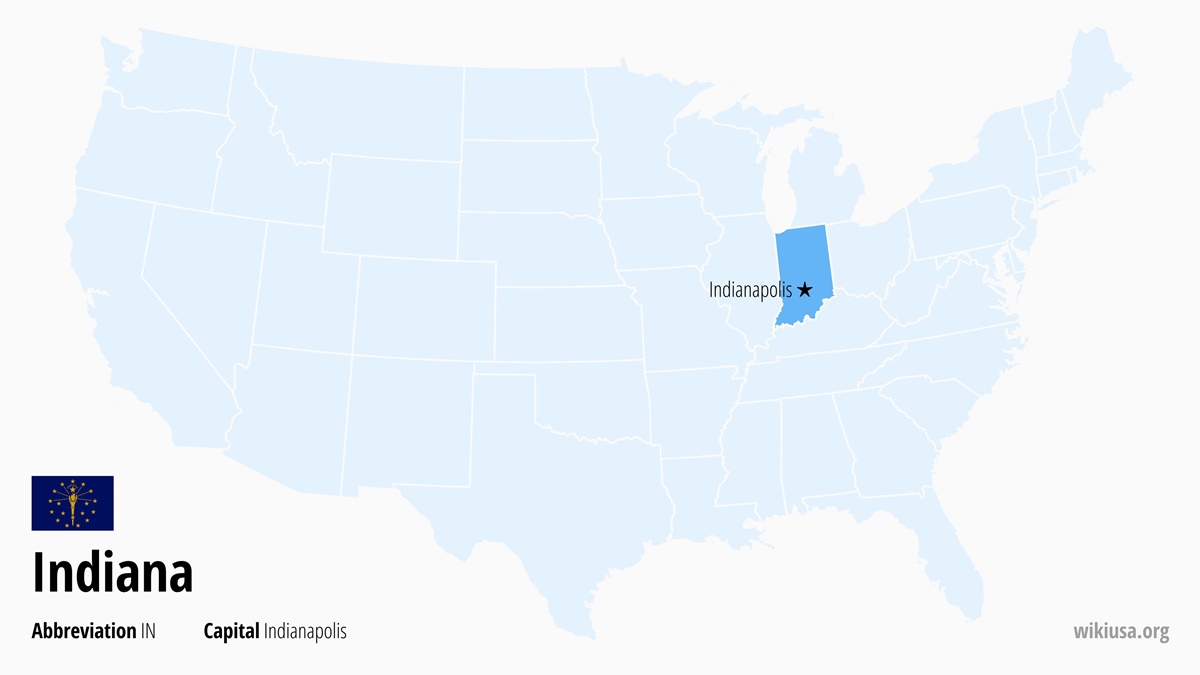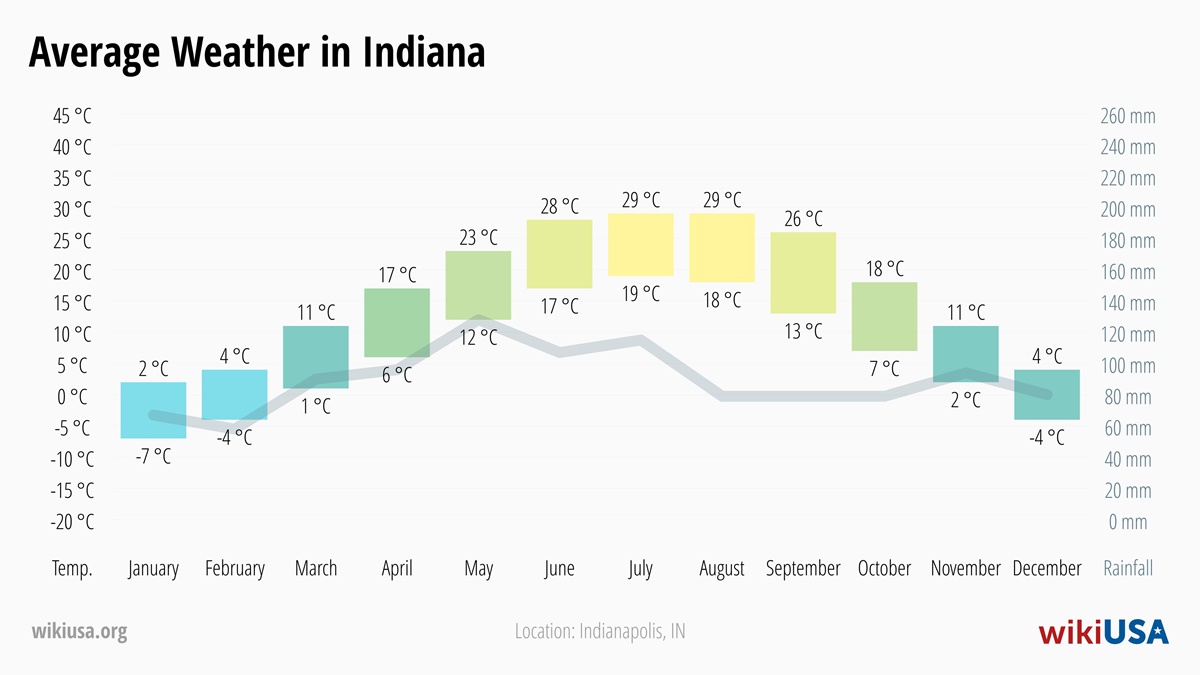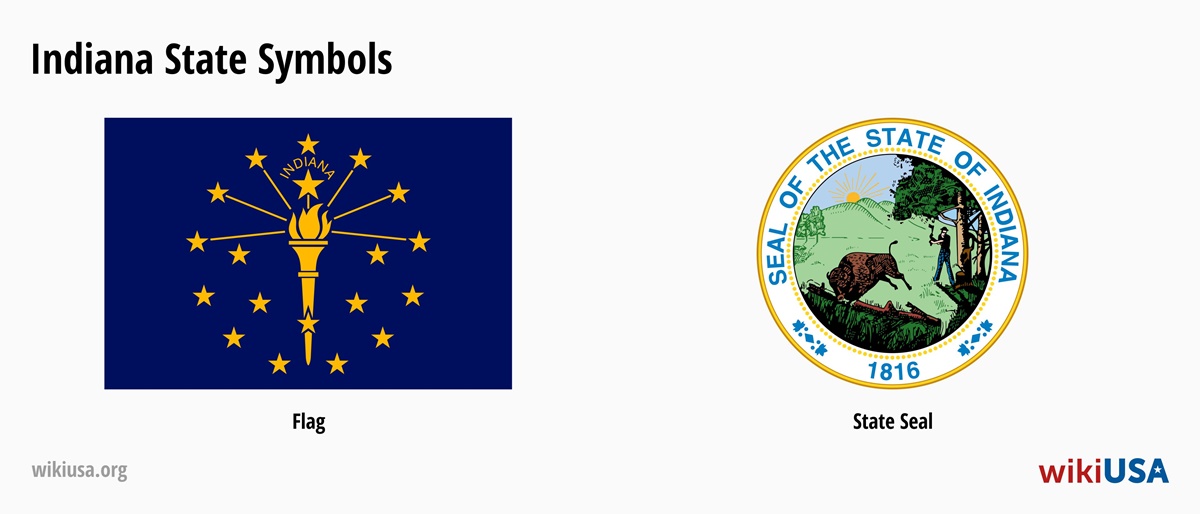Indiana (IN) is located in the American Midwest and is home to the famous Indianapolis 500 auto race. Indianapolis is both the state capital and its largest city. Indiana’s economy relies heavily on the automotive and steel industries, while agriculture is focused on producing corn and soybeans. One of the state’s top tourist attractions is the Indiana Dunes National Park.
-
Table of Contents
Basic Information
Name Indiana Abbreviation IN Capital Indianapolis Largest city Indianapolis (Population: 879 293) Current time 12:46 Time zone EST (UTC-5) time zone is in effect in most of the state’s districts, CST (UTC-6) is in effect in the remaining 12 districts. The state observes Daylight Saving Time EDT (UTC-4) and CDT (UTC-5) Population 6,785,442 (#17 most populous US state) Area 36,417 sqmi (#38 largest US state) Admitted to the Union December 11, 1816 (#19 state to join) ⭐ Capital of Indiana
The capital city of Indiana is Indianapolis, which was established for this purpose in 1821. It officially became the capital in 1825 upon its completion.
🏙️ Largest City in Indiana
The largest city in Indiana is Indianapolis, with a population of 879,293 in 2023. The second-largest city is Fort Wayne, with 269,994 residents, followed by Evansville, which has a population of 115,332.
🕒 Time in Indiana
The current time in Indianapolis is 12:46. Eastern Standard Time (EST, UTC-5) is observed in 80 of Indiana’s counties, shifting to Eastern Daylight Time (EDT, UTC-4) from March to November. The remaining 12 counties observe Central Standard Time (CST, UTC-6), switching to CDT (UTC-5) during daylight saving time.
🧑🤝🧑 Indiana’s Population
As of 2023, Indiana had a population of 6,785,442, making it the 17th most populous state in the United States.
📍 Area of Indiana
Indiana has a total area of 36,417 sqmi, of which 35,868 sqmi is land and 550 sqmi is water. In terms of size, it ranks as the 38th largest U.S. state.
-
Fun Facts About the State of Indiana
🧩 States Bordering Indiana
Indiana shares land borders with four U.S. states. To the west is Illinois, to the north Michigan, to the east Ohio, and to the south Kentucky. Additionally, it has a 40 mi-long shoreline along Lake Michigan to the north.
📅 Indiana’s Admission to the Union
Indiana joined the Union on December 11, 1816, becoming the 19th state, formed from the original Indiana Territory.
📛 Indiana’s Nickname
Indiana is nicknamed “The Hoosier State”, a term that, according to one theory, refers to the traditional designation for its residents. The origin of the word “Hoosier” is unclear, dating back to the 1840s, but it is still commonly used today in business names and sports teams.
⛰️ Highest Point in Indiana
The highest point in Indiana is Hoosier Hill in Wayne County, which stands at 1,257 ft.
🏞️ Rivers in Indiana
The longest river in Indiana is the Ohio River, with a total length of 981 mi across all states. Other major rivers include the Wabash River (503 mi), White River (362 mi), St. Joseph River (206 mi), and East Fork White River (192 mi).
🎓 Universities in Indiana
The largest university in Indiana is Purdue University, founded in 1869 in West Lafayette, with approximately 52,000 students. Other notable institutions include Indiana University Bloomington with 47,000 students, and Ball State University with around 20,000 students.
✉️ ZIP Codes in Indiana
Indiana is assigned the ZIP code range 460xx–479xx. For more information, read the article on ZIP Codes in the USA, or use the USPS ZIP code lookup tool to find a specific code.
-
Weather in Indiana
The best time to visit Indiana is in September and early October, when temperatures are still pleasant and nature is at its most beautiful.
Spring in Indiana is characterized by a significant warming trend. While in March, temperatures in Indianapolis usually range from 34 °F to 52 °F, by May they tend to be a very comfortable 54 °F to 73 °F. As temperatures rise, so does the amount of rainfall, with April and May being the wettest months. Passing weather fronts can produce strong thunderstorms, sometimes accompanied by hail.
Summer in Indiana is typically warm and humid. Between June and August, temperatures generally range from 64 °F to 84 °F. High humidity can make it feel even hotter. July and August frequently bring thunderstorms with heavy rain and strong winds.
Fall in Indiana brings a drop in temperatures—from the 55 °F to 79 °F typical in September to a noticeably cooler 36 °F to 52 °F in November. Rainfall is regular but usually light, making the first half of autumn a great time to admire the region’s natural beauty.
Winter in Indiana is quite cold, with temperatures from December to February generally ranging from 25 °F to 39 °F. On certain days and in some areas, they can drop significantly below 14 °F. Snowfall is common, with the heaviest accumulation typically occurring in January. In rural areas, freezing rain can sometimes cause travel disruptions.
🌡️ Average Temperatures and Precipitation in Indiana
-
What to See in Indiana
1️⃣ Indiana Dunes National Park
Indiana Dunes National Park stretches along the shore of Lake Michigan. Its main attraction is three specific sand dunes, the tallest of which, Mount Baldy, measures 120 ft. A popular activity is a timed challenge to conquer all three dunes. The area features around 50 mi of hiking trails of varying difficulty through dunes, forests, and wetlands.
2️⃣ Indianapolis Motor Speedway
The Indianapolis Motor Speedway is the track where the prestigious Indianapolis 500 is held. The stadium’s capacity is a staggering 250,000 people. It also houses a museum featuring trophies and historic race cars. For motorsport enthusiasts, touring the track is an unforgettable experience.
3️⃣ The Children’s Museum of Indianapolis
The largest children’s museum in the world is easy to spot thanks to the enormous dinosaur appearing to smash through the building. The museum offers a rich variety of interactive exhibits focused on science, history, culture, and art.
All exhibits are designed to be understandable for children, yet engaging enough for adults. Among the most popular sections are those dedicated to dinosaurs and space. It’s a perfect stop for families with kids.
4️⃣ Holiday World & Splashin’ Safari Amusement Park
Holiday World combines a traditional amusement park with roller coasters and a water park featuring attractions where you’re guaranteed to get soaked. The selection of slides and rides is extensive—some have even held world records.
Sections of the park are themed around different holidays, such as Christmas, Halloween, and Thanksgiving. There’s a good reason for this—the park is located in the town of Santa Claus.
5️⃣ Marengo Cave
Marengo Cave is one of the largest and most famous caves in Indiana. It is located in the town of Marengo, where it was discovered in 1883. Visitors can choose between two tour routes, offering a firsthand view of stunning stalactite formations. The cave is a protected national landmark, and in addition to the tours, there are nearby hiking trails available.
6️⃣ Indianapolis Zoo
The Indianapolis Zoo ranks among the best in the United States and includes an aquarium and a botanical garden. The pavilions are home to over 1,400 animals from around the world. The zoo is well-known for its interactive exhibits, where visitors can touch stingrays or watch dolphins during training sessions. The botanical garden features a variety of exotic and endangered plants.
7️⃣ Brown County State Park
Brown County is the largest state park in Indiana, best known for its scenic views of the rolling hills. The best time to visit is in the fall, when the deciduous trees turn vibrant shades of orange and red, attracting photographers and nature enthusiasts. The entire park is interwoven with a network of hiking trails, and visitors can stay overnight at designated campgrounds.
8️⃣ Newfields Art Museum
The Newfields Art Museum in Indianapolis houses an extensive collection of art spanning from antiquity to the present day. The museum’s holdings include works by European masters, Asian art, African sculptures, and American modern art. The museum is part of the larger Newfields campus, which regularly hosts exhibitions, workshops, and other cultural events.
9️⃣ Clifty Falls State Park
Clifty Falls State Park lies east of Indianapolis and is known for its rugged landscape and beautiful waterfalls. Several hiking trails lead to scenic viewpoints of the canyon and rock formations. Visitors can also explore historic railway tunnels, though some may be closed to the public. The park offers multiple campgrounds for overnight stays.
🔟 White River State Park
White River State Park is located in the heart of downtown Indianapolis. It is one of the largest urban parks in the state and features a zoo, museum, and several cultural institutions. The park offers a wide range of outdoor activities, bike trails, and picnic spots along the banks of the White River.
-
Largest Cities in Indiana
The table shows the ten largest cities in the state of Indiana in 2025, based on data from the federal agency United States Census Bureau, whose primary mission is to conduct the national census.
City County Population 1 Indianapolis Marion 879,293 Map of Indianapolis 2 Fort Wayne Allen 269,994 Map of Fort Wayne 3 Evansville Vanderburgh 115,332 Map of Evansville 4 Fishers Hamilton 104,094 Map of Fishers 5 South Bend St. Joseph 103,395 Map of South Bend 6 Carmel Hamilton 102,296 Map of Carmel 7 Bloomington Monroe 78,840 Map of Bloomington 8 Hammond Lake 76,193 Map of Hammond 9 Noblesville Hamilton 73,916 Map of Noblesville 10 Lafayette Tippecanoe 71,216 Map of Lafayette -
Sports Teams in Indiana
🏒 Hockey (NHL)
There is no NHL team based in Indiana.
🏈 American Football (NFL)
The Indianapolis Colts are the only NFL team from Indiana. They have played in the league since the 1953 season and belong to the AFC South Division. Until 1983, the team was based in Baltimore, Maryland, and was known as the Baltimore Colts. The team’s colors are royal blue and white. They play their home games at Lucas Oil Stadium in Indianapolis.
🏀 Basketball (NBA)
The Indiana Pacers have been part of the NBA since the 1976 season. The team is in the Central Division of the Eastern Conference. The team colors are navy blue, gold, and silver, and their home games are held at Gainbridge Fieldhouse in Indianapolis.
⚾ Baseball (MLB)
No MLB team is based in Indiana.
⚽ Soccer (MLS)
There is no MLS team based in Indiana.
-
State Symbols of Indiana
Official state symbols are determined by the Indiana General Assembly and become valid once the new law is signed by the governor. This article lists only some of the symbols.
Flag of the State of Indiana
The current design of the flag was adopted on May 31, 1917. It was created by Paul Hadley, a native of Indianapolis who worked as a design artist and watercolorist. The thirteen stars in the outer circle represent the original thirteen American colonies. The five stars in the inner circle stand for the five additional states admitted to the Union before Indiana. The single star at the top of the torch symbolizes Indiana itself.
Seal of the State of Indiana
Indiana’s Great Seal was adopted in 1816 when the state joined the Union, which is also indicated by the year at the bottom. The main elements of the seal are a leaping bison, a woodsman chopping down a tree, and a sun setting over the hills.
State Flower
In 1957, the peony (Paeonia) was chosen as the state flower. It grows throughout the state.
State Bird
The northern cardinal (Cardinalis cardinalis) is a songbird measuring between 21 cm and 23 cm in length. Males are known for their vivid red color, while females tend to be brownish with a hint of red. The cardinal has been the state bird since 1933 and is found in Indiana year-round.
State Tree
The tulip tree (Liriodendron tulipifera) was declared the official state tree in 1931. Commonly found in the eastern United States, it can grow as tall as 190 ft.
State River
In 1996, the Wabash River was designated as Indiana’s official state river. It originates in Ohio, flows through Indiana, and forms part of the border with Illinois. The total length of the Wabash River across all states is 503 mi.
State Snack
According to the U.S. Department of Agriculture, Indiana was the nation’s top popcorn producer in 2021, with most farms located in White and Pulaski counties. That same year, local legislation declared popcorn the official state snack.
State Stone
Indiana limestone is renowned across the United States and was used in the construction of the Empire State Building, the Pentagon, and 35 of the 50 U.S. state capitols. The typically white-gray stone has traditionally been quarried around the city of Bedford in southern Indiana. It has been the state stone since 1971.
State Firearm
Since 2012, one of Indiana’s official state symbols has been a firearm: the Grouseland Rifle. It was crafted in the early 19th century by gunsmith John Small for then-Governor William Henry Harrison. The rifle was named after the governor’s residence, Grouseland.
State Poem
Since 1963, the official state poem has been Indiana by poet Arthur Franklin Mapes. The poem celebrates the natural beauty of the state.

 10 Best Photo Places in the USA
10 Best Photo Places in the USA







Contribute with Your Question or Personal Experience